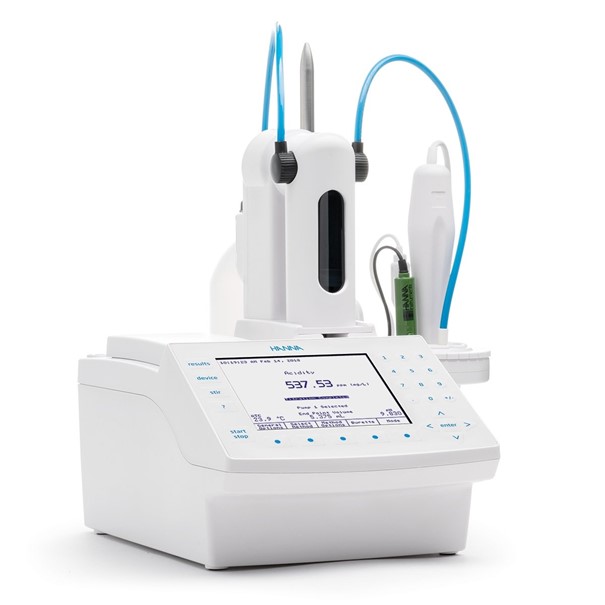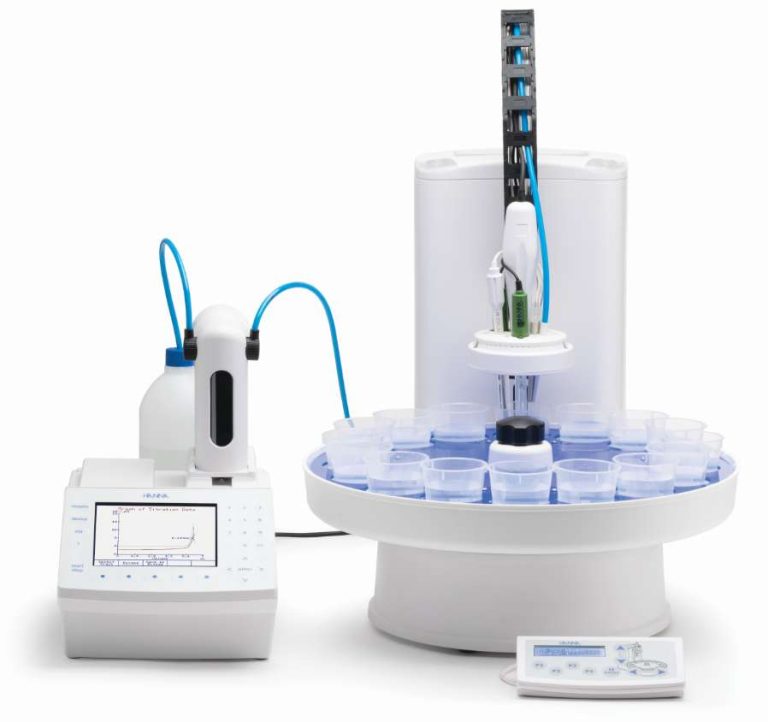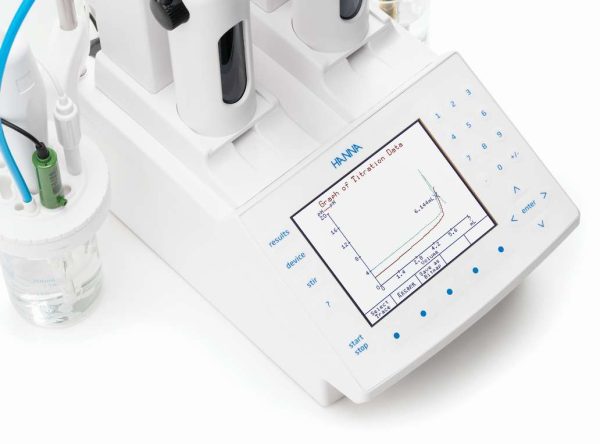

With an automatic titrator, you can save time and significantly reduce the amount of chemicals used in your laboratory, compared to the initial and maintenance costs.
Need assistance?
Titration is an often-used technique in various analytical laboratories. This is a type of volumetric analysis where a reagent of a known concentration (titrant) is gradually added to a sample with unknown analyte concentration. The point at which exactly enough titrant is added to react stoichiometrically with the analyte is called the equivalent point. Since the equivalence point is theoretical, in practice we determine the end point. The concentration of the analyte is calculated from the volume of titrant used to reach the endpoint. [1]
The titrant is added to the sample from the burette (glass tube with a graduated scale) until the endpoint is reached. This can be determined by observing the change in color of the indicator or potentiometrically (monitoring the change in potential between a pair of electrodes). [1]


Instead of manually adding the titrant and determining the endpoint, you can make your job easier by using an automatic titrator that will automatically add and record the volume of the titrant until the endpoint is (also automatically) determined.
Hanna Instruments Automatic Potentiometric Titrators (HI932 and HI931) can detect the endpoint potentiometrically (with pH, ORP or ion selective electrodes) or photometrically (with HI90060x photometric electrodes).
HI931
Automatic Potentiometric Titrator
The HI931 Automatic Titrator is the answer to your dedicated titration needs.
Fully customizable, the HI931 delivers accurate results and intuitive user experience, all in a compact package.
Titrate for a variety of measurements at the push of a button including acids, bases, redox, and selective ions.
No additional programming upgrades to purchase. The only things you need to start using the HI931 are a sensor and titrant.
- Small footprint so you can fully optimize your benchtop.
- Unmatched 40,000-step dosing pump for small volumes of titrant to help you achieve a very precise endpoint for greater consistency.
- Flexibility to store up to 100 methods.
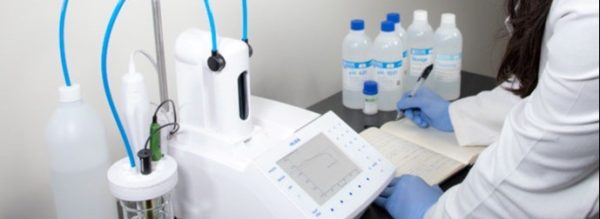

The following types of titrations can thus be performed with
Hanna Instruments Automatic Potentiometric Titrators:
- acid-base titrations using a pH electrode (e.g. HI1048B),
- redox titrations using an ORP electrode (e.g. HI3148B),
- complexometric titrations using ISE (e.g. Ca-ISE, Cu-ISE),
- argentometric titrations using a silver electrode (HI5148B),
- non-aqueous titrations using a modified pH or ORP electrode (HI1049B, HI3149B),
- titrations, where the endpoint is determined by an indicator, using a photometric electrode (HI90060X electrode series).
In which cases it would make sense to invest in an automatic titrator?
Let's look at some facts that can help you decide.
1 - Initial investment
For manual titration, a burette with stopcock, glass beakers, titrant and indicator are required. The cost of such equipment can be less than 100 euro (not including basic laboratory equipment such as analytical equipment, volumetric glassware, etc.). This set-up can be upgraded by using a suitable electrode, temperature probe, magnetic stirrer and an mV meter instead of an indicator (potentiometric endpoint determination). The costs in this case would increase by 1000-2000 euro.
Automating titrant dosing and endpoint determination can cost between 5500 and 30000 euro. The price depends on what level of automation is needed, the number of dosing pumps, the type and number of electrodes, and the titrator’s other capabilities (method linking, number of endpoints, the need for back-titrations etc.). As a minimum, the main titrator unit, dosing pump, burette, appropriate electrode, temperature probe, stirrer, beakers and titrant are required.


HI932
Advanced Automatic Potentiometric Titrator
- Total Acid Number (TAN)
- Total Base Number (TBN)
- ASTM D664
- ASTM D2896
- ASTM D4739
- ASTM D3227
- ASTM D1159
- Salts & Surfactants
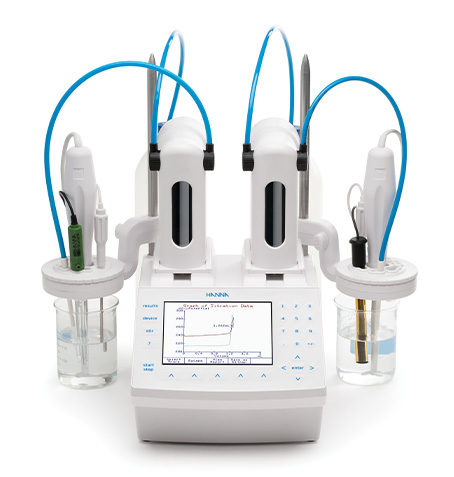

Installing and operating an automatic titrator can be difficult at first.
At Hanna Instruments we offer installation and training to help you get started.
2 - Maintenance
In addition to the initial purchasing costs, it is important to be aware that an automatic titrator requires maintenance. If this is neglected, the quality of the results will be reduced and irreparable damage to the pump or the main unit may occur.
Depending on the type of titrant, the aspiration tube, the dosing tube and the burette should be replaced once a year or once every two years.
The electrode has to be properly maintained (refilling the electrolyte, conditioning etc.) and has certain lifetime. Depending on the type of the electrode, it needs to be replaced every one to three years, depending on the type of electrode. It is also recommended to calibrate the analog board once a year.
With a conventional manual titration using an indicator, maintenance costs are minimal. If the end point is determined potentiometrically, the electrode must be maintained and replaced when needed (as in automation).
Our technicians can prepare a maintenance service plan that will ensure safety and accurate results.
3 - Time and number of samples
An important consideration when deciding on an automatic titrator is how many titrations we need to do in a given time and how much time we want to save for other work in the laboratory.
Automatic titrations can be done in under three minutes. By simply pressing the ‘’START’’ button, the automatic titrator will begin the titration. In the meantime, we can do other work in the laboratory (like preparing the next sample), and when we return, the results will be waiting for us on the display.
HI932 Automatic Potentiometric can be connected with HI922 Autosampler to analyze up to 18 samples consecutively.
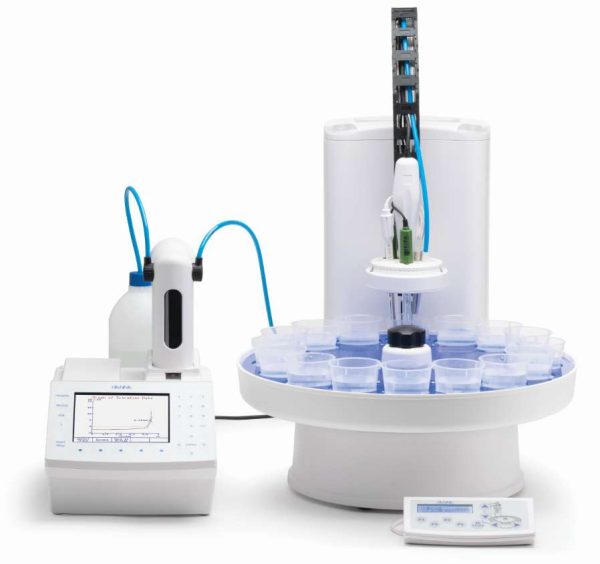

Manual titrations however require our full attention. After the addition of each drop, we have to carefully determine if the right color has appeared and if we over-titrate, the whole process has to be repeated, resulting in unnecessary wasted time. Only the most experienced laboratory technicians would be able to compete with an automatic titrator.
Furthermore, the automatic titrator saves us the work of calculating the results. Each method has the titration equation saved and results will be displayed right after the titration is finished. In the case of manual potentiometric determination, calculating the end point (maximum of the first derivative/zero of the second derivative) will take a lot of time.
HI922
HI922 Autosampler allows you to expand your sample handling capabilities. The autosampler is made to be used with the HI931 and HI932 Automatic Titration System and they interface together directly.
Chemically Resistant Pumps
To the HI922 you can connect up to three peristaltic pumps. These pumps can be used for reagent addition, sample leveling or waste removal. All components of the pumps are chemically resistant.
Optical IR Beaker Detection
An optical infrared (IR) beam is used to detect the presence and absence of each beaker. You can program the HI922 to handle a missing beaker how you deem fit; you can skip the missing beaker, pause the sequence, or stop the titration sequence.
An automatic titrator will determine the latter much more quickly and also much more precisely.
4 - Accuracy and repeatability
The following sources of errors must be considered in manual titrations:
a) Correct reading of the titrant level – when reading the titrant volume, your eye should be at the same height as the top of the liquid. If not, the reading will seem to be higher or lower than it really is. This error is called ‘’parallax’’. [1]
b) Subjective color perception in the case of indicator titrations – the manual addition of the titrant has to be stopped at a certain shade of color (for example very light pink in the case of phenolphthalein). Because each operator sees color differently, the results will be different for each operator. Colored samples can further complicate our work.
c) Low resolution of conventional burettes (0.1 mL – 0.2 mL) – having low burette resolution effects the accuracy of the final result. In the case of a manual potentiometric determination, the graph produced will have few points and the calculation of the maximum of the first derivative (over the zero of the second derivative) can give unreliable results.
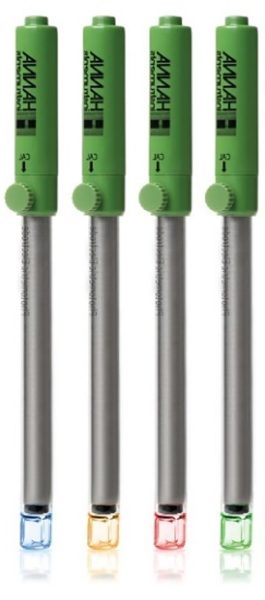

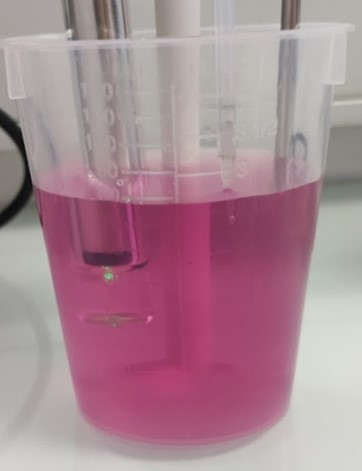

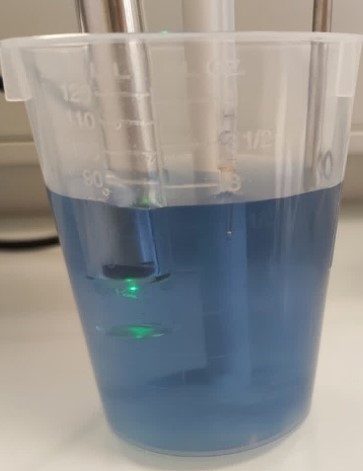

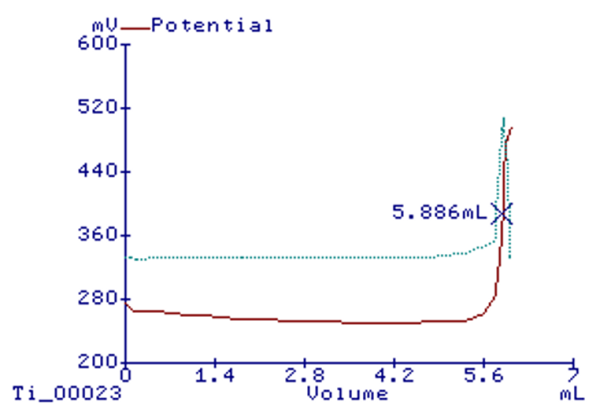

With an automatic titrator, these problems can be forgotten. Hanna Instruments Automatic Potentiometric Titrators use an un-matched 40,000-step piston driven pump, which means that it is possible to dose 1/40,000 of the burette volume (for a 25 mL burette it is 0.00625 mL).
Small additions of titrant enable us to obtain a high-resolution graph, consequently the calculation of the endpoint can be accurate and reliable. Furthermore, stored methods and electrodes keep the results the same, no matter who is doing the titration.
Want to follow your SOP that requires the use of the indicator and still automate?
With HI90060X series photometric electrodes there is no subjectivity, detecting color change is accurate and repeatable with minimal maintenance.
5 - Chemical consumption
A manual titration has to be repeated many times in order to achieve a reliable result. Like previously discussed, difficult endpoint determination can lead to over-titration. Consequently, more chemicals will be consumed and also a larger sample is required.
After the initial method optimization (with the help of our technicians) on the automatic titrator there is no more fear of low accuracy results, over-titrating and wasting expensive chemicals.
6 - Data storage and accessibility
Manual titrations also require handwritten reports. When we have to perform a large number of titrations, there is a higher possibility that errors and mix-ups occur in our notes. It is also important to consider how much information we need to have accessible about our titrations.
With a manual titration the only data that you receive is the titrant volume or if you do it potentiometrically, a low-resolution graph.
After each titration on the automatic titrator, a titration report will be stored that includes the date and time, method, sample size, volume of titrant used, duration of titration and graphs with all details (V(titrant), mV, mV/mL, T, t).
Potentiometric Titrators HI932 and HI931 can store up to 100 methods and 100 titration reports with all necessary GLP information, making data storage, organization and traceability much easier in the laboratory.
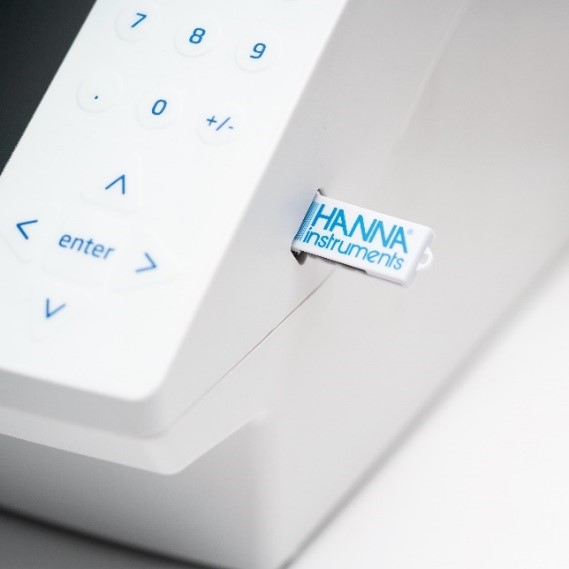

Results and methods can be transferred to a USB-stick, PC or printed directly.
Having all this data accessible and safely stored can be particularly useful in laboratories that need to report the results.
CONCLUSION
⇛ Do you need high accuracy and repeatability?
⇛ Do you need a better data management in your laboratory?
⇛ Do you want to save time and resources?
If you have answered yes to any of those questions, it would make sense to consider investing in an automatic titrator.
For further information contact us at info@hannaservice.eu.
HI90060x
Hanna Photometric Electrodes
for Use with our Automatic Potentiometric Titrators
ARTICLE: Petrochemical industry – Determination of TAN and TBN with Photometric probes
SOURCES:
[1] Harris, Daniel C., QUANTITATIVE CHEMICAL ANALYSIS Eighth Edition. New, York, W. H. Freeman and Company, 2010



